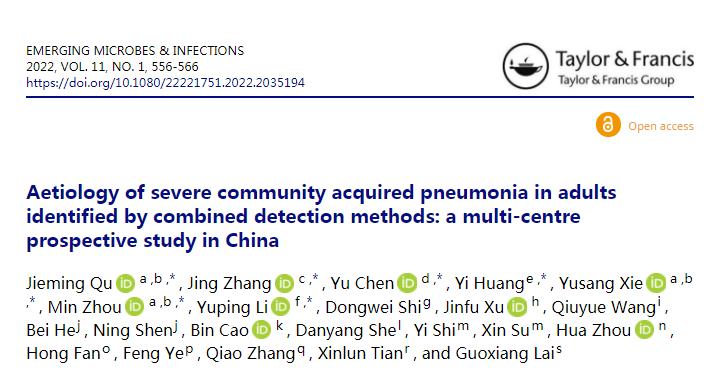2022年2月,瞿介明教授在《Emerging Microbes & Infections》杂志发表题名为「Aetiology of severe community acquired pneumonia in adults identified by combined detection methods: a multi-centre prospective study in China.」——中国成人重症社区获得性肺炎病原学调查:一项综合利用多种检测手段前瞻多中心研究的论文。
呼吸与危重症医学科瞿介明教授为论文的通讯作者兼第一作者,复旦大学附属中山医院张静主任医师、中国医科大学附属盛京医院呼吸与危重症医学科陈愉主任医师、海军军医大学附属长海医院呼吸与危重症医学科黄怡主任医师、呼吸与危重症医学科谢雨桑博士研究生、周敏主任医师、温州医科大学附属第一医院呼吸与危重症医学科李玉苹主任医师为论文的共同第一作者。

doi: 10.1080/22221751.2022.2035194.
重症社区获得性肺炎(SCAP)病原复杂、病死率高、预后差,是全球共同关注的重大公共卫生问题。我国SCAP疾病流行谱尚不完整,由中华医学会呼吸病分会感染学组发起,我们团队联合全国10个城市17家中心开展成人SCAP前瞻性、多中心临床流行病学调查,纳入收住于急诊科、呼吸科病房和呼吸重症监护室中,符合中国《成人社区获得性肺炎诊断和治疗指南(2016年版)》中SCAP诊断标准的成年患者,综合开展多项微生物标本检测,包括分中心常规微生物培养、尿检及血清学检测、中心实验室统一特殊病原体抗体检测、宏基因组二代测序(mNGS)等,长期连续随访临床资料,数据传入为本项目设计的在线病例随访系统。
本研究为首个提出综合病原学检测,并利用包括宏基因组二代测序在内多种检测手段分析我国SCAP病原学构成的研究。研究发现中国SCAP的主要致病原为流感病毒、肺炎链球菌和肠杆菌,其中流感有明显的季节分布性。早期即采用综合检测方法提高了致病原检出率,对患者生存有益。
Abstract
Severe Community Acquired Pneumonia (SCAP) challenges public health globally. Considerable improvements in molecular pathogen testing emerged in the last few years. Our prospective study combinedly used traditional culture, antigen tests, PCR and mNGS in SCAP pathogen identification with clinical outcomes. From June 2018 to December 2019, we conducted a multi-centre prospective study in 17 hospitals of SCAP patients within 48 hours of emergency room stay or hospitalization in China. All clinical data were uploaded into an online database. Blood, urine and respiratory specimens were collected for routine culture, antigen detection, PCR and mNGS as designed appropriately. Aetiology confirmation was made by the local attending physician group and scientific committee according to microbiological results, clinical features, and response to the treatment. Two hundred seventy-five patients were included for final analysis. Combined detection methods made identification rate up to 74.2% (222/ 299), while 14.4% (43/299) when only using routine cultures and 40.8% (122/299) when not using mNGS. Influenza virus (23.2%, 46/198), S. pneumoniae (19.6%, 39/198), Enterobacteriaceae (14.6%, 29/198), Legionella pneumophila (12.6%, 25/198), Mycoplasma pneumoniae (11.1%, 22/198) were the topfive common pathogens. The in-hospital mortality of patients with pathogen identified and unidentified was 21.7% (43/198) and 25.9% (20/77), respectively. In conclusion, early combined detection increased the pathogen identification rate and possibly benefitted survival. Influenza virus, S. pneumoniae, Enterobacteriaceae was the leading cause of SCAP in China, and there was a clear seasonal distribution pattern of influenza viruses. Physicians should be aware of the emergence of uncommon pathogens, including Chlamydia Psittaci and Leptospira.
中文摘要
重症社区获得性肺炎(SCAP)对全球公共卫生构成严峻挑战。在过去几年中分子病原检测技术发展迅速,我们籍此开展了一项多中心前瞻性病原学研究,利用包括常规微生物培养、抗原抗体检测、聚合酶链锁反应(PCR)和宏基因组二代测序(mNGS)在内的病原检测手段,并结合临床表现综合判定SCAP病原体。
自2018年6月至2019年12月纳入我国17家中心48小时内收治入院或急诊室的SCAP患者,所有临床数据均上传至在线数据库。并对患者血液、尿液和呼吸道标本利用上述综合检测技术进行微生物检测,由当地中心主管医生团队和本研究专家组根据各检测结果、患者临床特征和治疗反应确认本次致病原。
本研究共纳入275名患者在最终分析集,在综合检测手段下病原检出率为74.2%(222/299),而常规培养为14.4%(43/299),不使用mNGS时为40.8%(122/299)。我国SCAP的五大常见致病原依次为流感病毒(23.2%,46/198)、肺炎链球菌(19.6%,39/198)、肠杆菌(14.6%,29/198)、嗜肺军团菌(12.6%,25/198)、肺炎支原体(11.1%,22/198)。综合检测方法提高了致病原检出率,明确致病原与未明确患者的住院死亡率分别为21.7%(43/198)和25.9%(20/77)。
综上,流感病毒、肺炎链球菌、肠杆菌是中国SCAP的主要致病原,其中流感有明显的季节分布性。同时,我们需要重视包括鹦鹉热衣原体和钩端螺旋体在内的非常见病原体引起的感染。
作者简介

瞿介明
主任医师,教授,博士生导师,上海交通大学医学院附属瑞金医院呼吸与危重症医学科,上海交通大学医学院附属瑞金医院党委书记,中华医学会呼吸分会主任委员;研究方向:肺部感染。

周敏
主任医师,教授,博士生导师,上海交通大学医学院附属瑞金医院呼吸与危重症医学科科副主任;研究方向:慢性阻塞性肺病和肺部感染。

谢雨桑
博士研究生,上海交通大学医学院附属瑞金医院呼吸与危重症医学科,瞿介明教授博士生;研究方向:肺部感染。
本文内容来源自订阅号「瑞金医院图书馆」(ID:rjyytsg)


